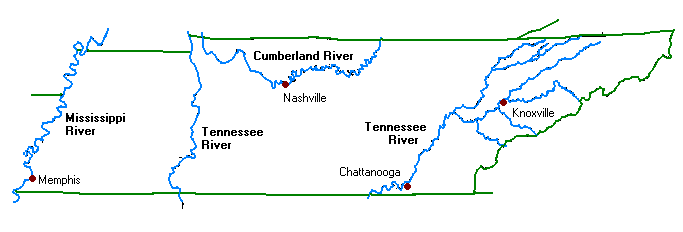 |
 |
Tennessee is blessed with an extensive river system that includes the Mississippi, Cumberland, and Tennessee Rivers and their tributaries. Native Americans and early European explorers paddled their canoes along these rivers, and by the late 18th century, modest river commerce emerged using keelboats, flatboats, and rafts. But substantial river trade required a form of motive power that could propel river vessels upstream as well as downstream, and at reasonably fast speeds. The Industrial Revolution provided the steam engine, which was applied to the propulsion of Tennessee's river vessels by the early 19th century. By the 1830s, steamboats dominated Tennessee's commercial transportation.
The Mississippi River
The first steamboat to ply Tennessee waters was the New Orleans, which navigated the Mississippi River along Tennessee's western border in 1811, a particularly eventful voyage that also witnessed the great New Madrid earthquake that formed Reelfoot Lake. Memphis became a major inland port, dominating much of the commerce of West Tennessee. The massive width and depth of the Mississippi ensured year-round navigation. Some of the Mississippi's tributaries provided much more modest steamboat transportation, including access to Dyersburg via the Forked Deer River, and a short stretch of the Hatchie River.
The Cumberland River
The General Jackson ran up the Cumberland River to Nashville in 1819. Nashville quickly became the dominant commercial center of Middle Tennessee. The Lower Cumberland (down stream from Nashville) was navigable year-round, and its ports enjoyed much success (notably Clarksville, a major exporter of dark-fired tobacco). The Upper Cumberland (above Nashville) was navigable only during winter and spring, but its ports (notably Carthage) nevertheless benefited greatly from steamboat traffic.
The Tennessee River
The Rocket navigated the Tennessee River as far as Florence (Alabama) in 1822, while the Atlas managed to traverse the hazardous Muscle Shoals (in north Alabama) and arrived at Chattanooga and Knoxville in 1828. Muscle Shoals proved to be a major navigation barrier (not fully resolved until the 20th century), so most steamboat activity occurred in open channels upstream and downstream of the Shoals. In spite of these problems, both Chattanooga and Knoxville enjoyed substantial steamboat commerce.
Early River Engineering
Steamboat navigation on Tennessee's rivers was always hazardous, and much early engineering effort was expended in attempts to provide clear open channels for safe passage of river vessels. Using a steam-powered device developed by Captain H. M. Shreve to remove "snags" (fallen trees), the U.S. Army Corps of Engineers cleared substantial portions of the Mississippi River, the Cumberland River, and the Tennessee River, funded by Congressional allocations during the 1830s. However, an 1836 attempt to construct a viable canal around Muscle Shoals did not improve steamboat navigation of that especially troublesome stretch of the Tennessee.
For additional information about Tennessee's antebellum steamboats,
see the Civil War River Transportation Bibliography.
![]() Tennessee
Civil War River Transportation
Tennessee
Civil War River Transportation
Last update: May 29, 2000